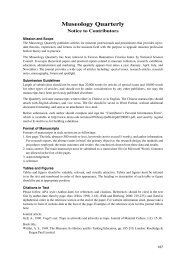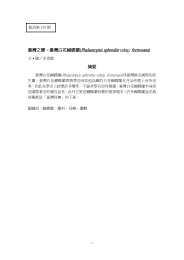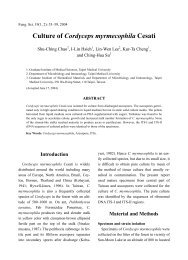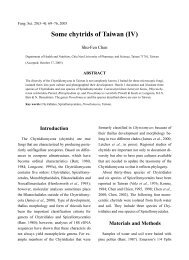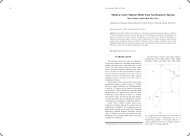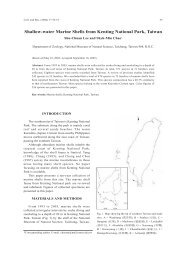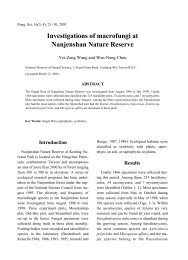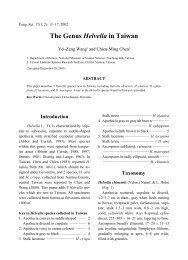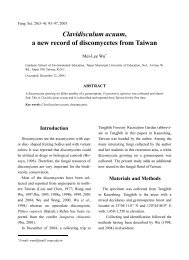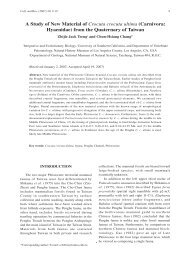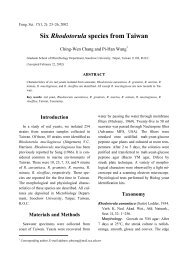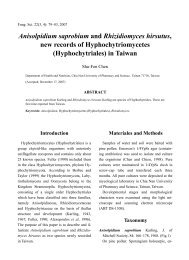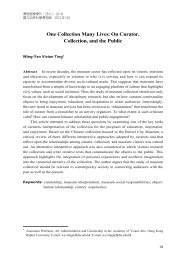Trichocladium anamorph of Ascotaiwania hsilio and Monodictys-like ...
Trichocladium anamorph of Ascotaiwania hsilio and Monodictys-like ...
Trichocladium anamorph of Ascotaiwania hsilio and Monodictys-like ...
You also want an ePaper? Increase the reach of your titles
YUMPU automatically turns print PDFs into web optimized ePapers that Google loves.
36 Fung. Sci. 16(3, 4), 2001<br />
morphology, though closely related to T. alopallonelum<br />
(Meyer <strong>and</strong> Moore) Kohlm. &<br />
Volkm.-Kohlm. <strong>and</strong> T. nypae K.D. Hyde &<br />
Goh in shape <strong>of</strong> conidia but conidia <strong>of</strong> this<br />
<strong>anamorph</strong> with only one septum <strong>and</strong> hemispherical<br />
basal cell. This <strong>Trichocladium</strong> species<br />
is also differs from T. uniseptatum Berk.&<br />
broome, the <strong>anamorph</strong> <strong>of</strong> Ascolacicola aquatic<br />
Ranghoo et K.D. Hyde, in its globose conidia<br />
<strong>and</strong> without distinct conidiogenous cells.<br />
Anamorphic state <strong>of</strong> this fungus is also present<br />
along with teleomorph, in natural substrate on<br />
decayed tree twigs collected from stream in<br />
Wulai, Taipei county.<br />
<strong>Monodictys</strong>-<strong>like</strong> <strong>anamorph</strong> <strong>of</strong> <strong>Ascotaiwania</strong><br />
lignicola (Fig. 2)<br />
Colonies effuse, conidiophores micronema-<br />
tous to semi-macronematous, mononematous,<br />
flexuous, brown, smooth, swollen. Conidiogenous<br />
cells monoblastic, integrated, determinate,<br />
cylindrical. Conidia ellipsoidal or subspherical,<br />
multicellular, mostly aggregate, constricted at<br />
septa, dark reddish brown to almost dark,<br />
smooth, 29.50–42.75 × 17.25–44.50 µm.<br />
This <strong>Monodictys</strong>-<strong>like</strong> <strong>anamorph</strong> seems<br />
closely to M. putredinis (Wallr.) Hughes in<br />
conidial morphology. In one culture teleomorph,<br />
the perithecia <strong>of</strong> A. lignicola with mature<br />
ascospores, were also observed formed<br />
along with <strong>anamorph</strong> on autoclaved corn leaf<br />
section placed on Sach’s medium.<br />
Although conidia <strong>of</strong> <strong>Trichocladium</strong> <strong>and</strong><br />
<strong>Monodictys</strong> are different in their morphology,<br />
they are similar in conidium ontogeny. <strong>Trichocladium</strong><br />
<strong>and</strong> <strong>Monodictys</strong> are frequently en-<br />
Fig. 1. Anamorph <strong>of</strong> <strong>Ascotaiwania</strong> <strong>hsilio</strong>, a <strong>Trichocladium</strong> fungus: A <strong>and</strong> B, conidia <strong>and</strong> conidium formation. Bar scale:<br />
20 µm.



